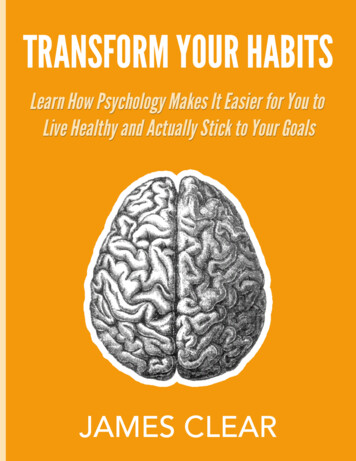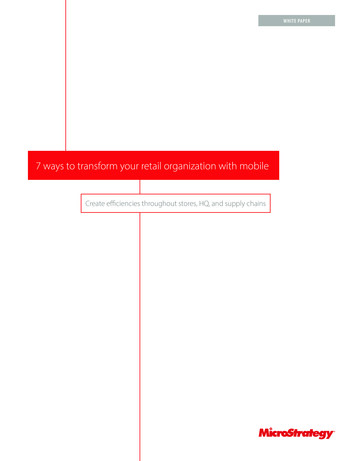
Transcription
1
2TRANSFORM YOUR HABITS2nd EditionTransform Your Habits is a free guide written by James Clear. You are welcometo share it with anyone you think it would benefit.For more ideas on how to master your habits, improve your performance, andboost your mental and physical health, you can visit JamesClear.com or joinJames Clear's free newsletter at http://jamesclear.com/newsletter
310 THINGS THIS GUIDE WILL TEACH YOU1. How to reverse your bad habits and stick to good ones.2. The science of how your brain processes habits.3. The common mistakes most people make (and how to avoid them).4. How to overcome a lack of motivation and willpower.5. How to develop a stronger identity and believe in yourself.6. How to make time for new habits (even when your life gets crazy).7. How to design your environment to make success easier.8. How to make big changes in your life without overwhelming yourself.9. How to get back on track when you get off course with your goals.10. And most importantly, how to put these ideas into practice in real life.
4Table of ContentsWhy Is It So Hard to Stick to Good Habits?5The Common Mistake You Want to Avoid6The Science of How Your Habits Work9Identity-Based Habits: How to Actually Stick to Your Goals17The Best Way to Start Your New Habit24How to Fit New Habits Into Your Life27How to Make Big Changes Without Overwhelming Yourself31How to Get Back on Track After Slipping Up34How to Break a Bad Habit (and Replace it With a Good One)39The Next Step: Where to Go From Here45
5Why Is It So Hard to Stick to Good Habits?It seems to be remarkably easy to fall into unhealthy routines. Eating junk food. Watching TV instead of going to the gym. Showing up to a job you hate everyday. Biting your nails. Smoking.There's no shortage of unhealthy and unproductive behaviors. And we allstruggle with them from time to time.But why? You want to live a healthy, fulfilling, and remarkable life. And everynow and then you probably get really motivated and inspired to make a change.So how come it is more likely that this time next year you'll be doing the samething rather than something better? Why is it so hard to stick to good habits?I believe that it is because we usually try to make changes in the wrong way.And in this guide, I'm going to share a blend of science and real-worldexperiences that share a better strategy for making long-term changes in yourlife.Let's get started.
6The Common Mistake You Want to AvoidYour audacious life goals are fabulous. We’re proud of you for havingthem. But it’s possible that those goals are designed to distract youfrom the thing that’s really frightening you—the shift in daily habitsthat would mean a re–invention of how you see yourself.—Seth GodinTransformations and overnight successes get a lot of hype. (For good reason,who wouldn't want to be more successful in less time?)But here's the problem: when you hear about a dramatic transformation (likesomeone losing 100 pounds) or a incredible success story (like someonebuilding a million dollar business in 1 year), the only thing you know is theevent that people are talking about. You don't hear anything about the processthat came before it or about the habits that led to the eventual result.It's easy to let these incredible stories trick you into doing too much, too soon. Iknow I've done it. When you get motivated and inspired to take your life to thenext level, it's so easy to get obsessed with the result. I need to lose 20 pounds(or 40 or 60 or 100). I need to squat 300 pounds (or 400 or 500). I need tomeditate 3 days per week (or 5 or 7).Or thousands of other variations of your life goals.It's natural to think that we need the result, the transformation, the overnightsuccess. But that's not what you need. You need better habits.
7It’s so easy to overestimate the importance of one defining moment andunderestimate the value of making better decisions on a daily basis.Almost every habit that you have — good or bad — is the result of many smalldecisions over time. And if this is true, if the problems you’re facing now are theresult of thousands of small decisions made over the course of years, thenwouldn’t it make sense that path to success, health, strength, joy, fulfillment,meaning, and vitality would also be through thousands of daily decisions?And yet, how easily we forget this when we want to make a change.When you become obsessed with achieving a result quickly, the only thing youthink about is how to get to your goal, and you forget to realize that our processfor achieving goals is just as important as whether or not you achieve them atall. The desire to achieve results quickly fools you into thinking that the result isprize.But here's the truth Becoming the type of person you want to become — someone who lives by astronger standard, someone who believes in themselves, someone who can becounted on by the people that matter to them — is about the daily process youfollow and not the ultimate product you achieve.Why is this true? Because your life today is essentially the sum of your habits.How in shape or out of shape you are? A result of your habits.How happy or unhappy you are? A result of your habits.How successful or unsuccessful you are? A result of your habits.
8What you repeatedly do (i.e. what you spend time thinking about and doingeach day) ultimately forms the person you are, the things you believe, and thepersonality that you portray.The most common mistake that people make is setting their sights on an event,a transformation, an overnight success they want to achieve – rather thanfocusing on their habits and routines.I've been guilty of this just like everyone else. And even today, I'm still learninghow to master my habits just like you.But over time, I've discovered a helpful blend of academic research and realworld experiences that have allowed me to make progress in many areas of life.In this guide, I want to share that progress with you so that you can avoidchasing another overnight success and actually stick to your goals for the longterm.Let's get started by talking about the science of sticking to good habits.
9The Science of How Your Habits Work(The 3 R's of Habit Change)There is a simple 3–step pattern that every habit follows. I call this pattern the“3 R's of Habit Change” and it goes like this.1. Reminder (the trigger that initiates the behavior)2. Routine (the behavior itself; the action you take)3. Reward (the benefit you gain from doing the behavior)This sequence has been proven over and over again by behavioral psychologyresearchers. I originally learned of this cycle from Stanford professor, BJ Fogg.And more recently, I read about it in Charles Duhigg’s best–selling book, ThePower of Habit.(Duhigg’s book refers to the three steps as cue, routine, reward. Regardless ofhow it's phrased, the point is that there is a lot of science behind the process ofhabit formation, and so we can be relatively confident that your habits followthe same cycle.)Let me show you what the 3 R's look like in real life by applying the frameworkto a typical habit. (In this case, answering a phone call.)Step One: Your phone rings (reminder). This is the reminder that initiates thebehavior. The ring acts as a trigger or cue to tell you to answer the phone. It isthe prompt that starts the behavior.
10Step Two: You answer your phone (routine). This is the actual behavior.When your phone rings, you have a habit of answering it.Step Three: You find out who is calling (reward). The reward is the benefitgained from doing the behavior. In this case, the reward for completing thehabit was satisfying your curiosity to find out why the other person was callingyou.Result: If the reward is positive, then the cycle forms a positive feedback loopthat tells your brain, “Next time this reminder happens, do the same thing.”(i.e. When the phone rings again, answer it.)Follow this same cycle enough times and you'll stop thinking about it. Yourbehavior will just become a habit.All habits form by the same 3–step process. (Graphic based on CharlesDuhigg’s “Habit Loop” in The Power of Habit. Created by James Clear.)
11How can you use this structure to create new habits and actually stick to them?Here’s how Step 1: Use a Current Habit as the Reminder for Your New OneIf you talk to your friends about starting a new habit, they might tell you thatyou need to exercise self–control or that you need to find a new dose ofwillpower.I disagree.Getting motivated and trying to remember to do a new behavior is the exactwrong way to go about it. If you think about this, it makes sense. Sometimesyou feel motivated and sometimes you don't, right? So why would you want torely on motivation (something that changes) to create a new habit (somethingthat you want to be consistent)?This is why the reminder – the trigger for your new behavior – is such a criticalpart of forming new habits. A good reminder makes it easier for you to startyour habit by encoding your new behavior in something that you already do,rather than relying on getting motivated.For example, I created a new habit of flossing each day by always doing it afterbrushing my teeth. The act of brushing my teeth was something that I alreadydid and it acted as the trigger or cue to do my new behavior.To make things even easier and prevent myself from having to remember tofloss, I bought a bowl, placed it next to my toothbrush, and put a handful ofpre–made flossers in it. Now I see the floss every time I reach for mytoothbrush.
12Setting up a visible reminder and linking my new habit with a current behaviormade it much easier to change. No need to be motivated. No need to remember.How to Choose Your ReminderIt doesn’t matter if it’s working out or eating healthy or creating art, you can’texpect yourself to magically stick to a new habit without setting up a systemthat makes it easier to start. And for that reason, picking the correct reminderfor your new habit is the first step to making change easier.The reminder that you choose to initiate your new behavior is specific to yourlife and the habit that you're trying to create.The best way I know to discover a good reminder for your new habit is to writedown two lists. In the first list, write down the things that you do each daywithout fail.For example Get in the shower. Put your shoes on. Brush your teeth. Flush the toilet. Sit down for dinner. Turn the lights off. Get into bed.You’ll often find that many of these items are daily health habits like washingyour face, drinking morning tea, brushing your teeth, and so on. Those actionscan act as reminders for new health habits. For example, “After I drink my
13morning tea, I meditate for 60 seconds.”In the second list, write down the things that happen to you each day. You stop at a red light. You get a text message. A commercial comes on TV. A song ends. The sun sets.These events can also act as triggers for your new habit. For example, if youwanted to “When a commercial comes on TV, I do five pushups.”With these two lists, you’ll have a wide range of things that you already do andalready respond to each day. Those are the perfect reminders for new habits.For example, let’s say you want to feel happier. Expressing gratitude is oneproven way to boost happiness. Using the list above, you could pick thereminder “sit down for dinner” and use it as a cue to say one thing that you’regrateful for today.“When I sit down for dinner, I say one thing that I’m grateful for today.”That’s the type of small behavior that could blossom into a more gratefuloutlook on life in general.Step 2: Make Your Habits Incredibly Easy to StartMake it so easy you can’t say no.—Leo Babauta
14As I mentioned in the beginning of this guide, it’s incredibly easy to get caughtup in the desire to make massive changes in your life. We watch incredibleweight loss transformations and think that we need to lose 30 pounds in thenext 4 weeks. We see elite athletes on TV and wish that we could run faster andjump higher tomorrow. We want to earn more, do more, and be more rightnow.I’ve felt those things too, so I get it. And in general, I applaud the enthusiasm.I’m glad that you want great things for your life and I want to do what I can tohelp you achieve them. But it’s important to remember that lasting change is aproduct of daily habits, not once-in-a-lifetime transformations.If you want to start a new habit and begin living healthier and happier, then Ihave one suggestion that I cannot emphasis enough: start small. In the wordsof Leo Babauta, “make it so easy that you can’t say no.”How small? Stanford professor BJ Fogg suggests that people who want to startflossing begin by flossing only one tooth. Just one.In the beginning, performance doesn’t matter. What does matter is becomingthe type of person who always sticks to your new habit – no matter how smallor insignificant it seems. You can build up to the level of performance that youwant once the behavior becomes consistent.Your homework: Pick a new habit you want to start. Now ask yourself, “Howcan I make this new behavior so easy to do that I can’t say no?”Step 3: Always Reward YourselfIt’s important to celebrate. (I think that’s just as true in life as it is with habits.)
15When it comes to sticking to better habits, there is an important reason toalways reward yourself: we want to continue doing things that make us feelgood.And that is why it’s especially important that you reward yourself each time youpractice your new habit.For example, if I’m working towards a new fitness goal, then I’ll often tellmyself at the end of a workout, “That was good day.” Or, “Good job. You madeprogress today.”If you feel like it, you could even tell yourself “Victory!” or “Success!” each timeyou do your new habit.I haven’t done this myself, but some people swear by it. Floss one tooth. “Victory!” Eat a healthy meal. “Success!” Do five pushups. “Good work!”Rewarding yourself with positive self–talk can take some getting used to ifyou’re not someone who typically does that. But even if it sounds silly, researchhas proven that the reward is an important part of the habit process. Giveyourself some credit and enjoy each small success.Related note: Make sure that the habits you are trying to build are actuallyimportant to you. It’s tough to find a reward in something when you’re onlydoing it because you think other people expect it or would approve of it. It'syour life, so make sure you're spending your time on things that areimportant to you.
16Now that we've covered the science of habit formation, let's talk about how touse it in real life.
17Identity-Based Habits: How to Actually Stickto Your Goals For the Long-TermWe've covered the science of habit formation. But in the real world, there isoften a difference between theory and practice.Whenever I write, I do my best to not merely share ideas backed by science, butalso to highlight real-world lessons that make it easier for you to put thoseideas into practice.This is especially important when it comes to building better habits. We allwant to become better people — stronger and healthier, more creative andmore skilled, a better friend or family member. But even if we get reallyinspired and start doing things better, it’s tough to actually stick to newbehaviors. It’s more likely that this time next year you’ll be doing the samething than performing a new habit with ease.Luckily, you can use a strategy that I call “identity-based habits” to makechange easier and stick to your goals over the long-term.Here's how it works.What Remembering Names Can Teach You About HabitsMy girlfriend is great at remembering people’s names.
18Recently, she told me a story that happened when she was in high school. Shewent to a large high school and it was the first day of class. Many of thestudents had never met before that day. The teacher went around the room andasked each person to introduce themselves. At the end, the teacher asked ifanyone could remember everyone’s name.My girlfriend raised her hand and proceeded to go around the room andaccurately name all 30 or so people. The rest of the room was stunned. The guynext to her looked over and said, “I couldn’t even remember your name.”She said that moment was an affirming experience for her. After that happenedshe felt like, “I’m the type of person who is good at remembering people’snames.”Even today, she is great at remembering the names of anyone we come across.Here’s what I learned from that story: In order to believe in a new identity, wehave to prove it to ourselves.Identity-Based Habits: How to Build Lasting HabitsThe key to building lasting habits is focusing on creating a new identity first.Your current behaviors are simply a reflection of your current identity. Whatyou do now is a mirror image of the type of person you believe that you are(either consciously or subconsciously).To change your behavior for good, you need to start believing new things aboutyourself.Imagine how we typically set goals. We might start by saying “I want to loseweight” or “I want to get stronger.” If you’re lucky, someone might say, “That’s
19great, but you should be more specific.”So then you say, “I want to lose 20 pounds” or “I want to squat 300 pounds.”These goals are centered around our performance or our appearance.Performance and appearance goals are great, but they aren’t the same as habits.If you’re already doing a behavior, then these types of goals can help drive youforward. But if you’re trying to start a new behavior, then I think itwould be far better to start with an identity–based goal.
20The image below shows the difference between identity–based goals andperformance and appearance–based goals.Graphic by James Clear.The interior of behavior change and building better habits is your identity. Eachaction you perform is driven by the fundamental belief that it is possible. So ifyou change your identity (the type of person that you believe that you are), thenit’s easier to change your actions.The reason why it’s so hard to stick to new habits is that we often try to achievea performance or appearance–based goal without changing our identity. Mostof the time we try to achieve results before proving to ourselves that we havethe identity of the type of person we want to become.It should be the other way around.
21The Recipe for Sustained SuccessChanging your beliefs isn’t nearly as hard as you might think. There are twosteps.1. Decide the type of person you want to be.2. Prove it to yourself with small wins.Note: I cannot emphasize enough how important it is to start with incrediblysmall steps. The goal is not to achieve results at first, the goal is to become thetype of person who can achieve those things.For example, a person who works out consistently is the type of person who canbecome strong. Develop the identity of someone who works out first, and thenmove on to performance and appearance later. Start small and trust that theresults will come as you develop a new identity.On the next page, you'll find five examples of how you can use identity-basedhabits in real life.
22Example 1: Want to lose weight?Identity: Become the type of person who moves more every day.Small win: Buy a pedometer. Walk 50 steps when you get home from work.Tomorrow, walk 100 steps. The day after that, 150 steps. If you do this 5 daysper week and add 50 steps each day, then by the end of the year, you’ll bewalking over 10,000 steps per day.Example 2: Want to become a better writer?Identity: Become the type of person who writes 1,000 words every day.Small win: Write one paragraph each day this week.Example 3: Want to become strong?Identity: Become the type of person who never misses a workout.Small win: Do pushups every Monday, Wednesday, and Friday.Example 4: Want to be a better friend?Identity: Become the type of person who always stays in touch.Small win: Call one friend every Saturday. If you repeat the same people every3 months, you’ll stay close with 12 old friends throughout the year.Example 5: Want to be taken seriously at work?Identity: become the type of person who is always on time.
23Small win: Schedule meetings with an additional 15–minute gap between themso that you can go from meeting to meeting and always show up early.What is your identity?In my experience, when you want to become better at something, proving youridentity to yourself is far more important than getting amazing results. This isespecially true at first.If you want to get motivated and inspired, then feel free to watch a YouTubevideo, listen to your favorite song, or try P90X. But don’t be surprised if youburn out after a week. You can’t rely on being motivated to make lastingchanges in your life. You have to become the type of person you want to be, andthat starts with proving your new identity to yourself.If you’re looking to make a change, then I say stop worrying about results andstart worrying about your identity. Become the type of person who can achievethe things you want to achieve. Build the habit now. The results can come later.Combining Strategies for Maximum SuccessIdentity-based habits offer a framework through which to view your goals. The3 R's of habit change provide a plan for achieving your new identity. Combiningboth of these ideas can make change easier for you overall.In other words, identity-based habits keep you focused on the right things: likestarting small, building your identity, and not worrying about results.Meanwhile, the 3 R's of habit change make sure that you do things in the rightway: like linking your new habit to a current behavior and rewarding yourselffor a job well done.
24The Best Way to Start Your New HabitIf you’re serious about doing things better than you are now – in other words, ifyou're serious about sticking to good habits – then you have to start small.Imagine the typical habits, good or bad: Brushing your teeth. Putting yourseatbelt on. Biting your nails.These actions are small enough that you don’t even think about them. Yousimply do them automatically. They are tiny actions that become consistentpatterns.Wouldn’t it make sense that if we wanted to form new habits, the best way tostart would be to make tiny changes that our brain could quickly learn andautomatically repeat?What if you started thinking of your life goals, not as big, audacious things thatyou can only achieve when the time is right or when you have better resourcesor when you finally catch your big break but instead as tiny, daily behaviorsthat are repeated until success becomes inevitable?What if losing 50 pounds wasn’t dependent on a researcher discovering theperfect diet or you finding a superhuman dose of willpower, but hinged on aseries of tiny habits that you could always control? Habits like walking for 20minutes per day, drinking 8 glasses of water per day, eating two meals insteadof three.
25Too often we get obsessed with making life–changing transformations. I believeyou would make more progress by focusing on lifestyle behaviors. Losing 50 pounds would be life–changing, drinking 8 glasses of waterper day is a new type of lifestyle. Publishing your first book would be life–changing, emailing a new bookagent each day is a new type of lifestyle. Running a marathon would be life–changing, running 3 days per week isa new type of lifestyle. Earning an extra 20,000 each year would be life–changing, working anextra 5 hours per week as a freelancer is a new type of lifestyle. Squatting 100 more pounds would be life–changing, squatting 3 daysper week is a new type of lifestyle.Do you see the difference?I think the following quote from BJ Fogg, a professor at Stanford University,sums this idea up nicely.If you plant the right seed in the right spot, it will grow without furthercoaxing. I believe this is the best metaphor for creating habits.The “right seed” is the tiny behavior that you choose. The “right spot” isthe sequencing — what it comes after. The “coaxing” part is amping upmotivation, which I think has nothing to do with creating habits. Infact, focusing on motivation as the key to habits is exactly wrong.Let me be more explicit: If you pick the right small behavior andsequence it right, then you won’t have to motivate yourself to have itgrow. It will just happen naturally, like a good seed planted in a goodspot.—BJ FoggHow great is that?
26The typical approach is to dive into the deep end as soon as you get a dose ofmotivation, only to fail quickly and wish you had more willpower as your newhabit drowns. The new approach is to wade into the shallow water, slowly goingdeeper until you reach the point where you can swim whether you’re motivatedor not.Daily habits — tiny routines that are repeatable — are what make big dreams areality. Dream big, but start small.
27How to Fit New Habits Into Your LifeKnowing how to make changes is one thing, but fitting new goals into your lifeis something else entirely.Making changes is tough. Whenever your schedule get crazy, the inertia of lifecan pull you away from your goals and right back into your old habits.How can you overcome this tendency to fall off course and make time for newgoals in your schedule?Using the strategies already mentioned in this guide – like the 3 R's of habitchange and identity-based habits – will help keep you on track.But those strategies aren't the only tools at your disposal. In this section, I'llshare another way to stick to good habits that doesn't require incredible dosesof willpower or remarkable motivation. I'll also share two examples of how I'veused this strategy successfully in my own life.The Problem With How We Usually Set GoalsIf you’re anything like the typical human, then you have dreams and goals inyour life. In fact, there are probably many things — large and small — that youwould like to accomplish.That’s great, but there is one common mistake we often make when it comes to
28setting goals. (I know I’ve committed this error many times myself.)The problem is this: we set a deadline, but not a schedule.We focus on the end goal that we want to achieve and the deadline we want todo it by. We say things like, “I want to lose 20 pounds by the summer” or “Iwant to add 50 pounds to my bench press in the next 12 weeks.”The problem with this strategy is that if we don’t achieve the arbitrary timelinethat we set in the beginning, then we feel like a failure even if we are betteroff than we were at the start. The end result, sadly, is that we often give up if wedon’t reach our goal by the initial deadline.Here’s the good news: there’s a better way and it’s simple.The Power of Setting a Schedule, Not a DeadlineIn my experience, a better way to approach your goals and build good habits isto set a schedule to operate by rather than a deadline to perform by.Instead of giving yourself a deadline to accomplish a particular goal by (andthen feeling like a failure if you don’t achieve it), you should choose a goal thatis important to you and then set a schedule to work towards it consistently.That might not sound like a big shift, but it is.The Idea in PracticeMost of the time, I try to be a practitioner of my ideas and not just someonewho shares their opinion, so allow me to explain this strategy by using two realexamples from my own life.
29Example 1: WritingI publish a new article every Monday and Thursday. Since my first article onNovember 12, 2012, I’ve been delivering two articles per week, every week.Sometimes the article is shorter than expected, sometimes it’s not ascompelling as I had hoped, and sometimes it’s not as useful as it could be butit gets out to the world nonetheless.Of course, I didn't always operate on a Monday-Thursday schedule. In fact, Icame up with reasons for actively avoiding a schedule. I told myself, “I do mybest writing when I'm inspired, so I'll just wait until I get the urge to write.”I assumed that if I wasn't doing my best work, then I shouldn't be doing it at all.The problem with that strategy is that my output was erratic at best.It took me awhile to realize it, but it's not about always doing your best work,it's about doing the best you can on a consistent basis.Once I stopped focusing on results and simply held myself to a consistentschedule, my work and my output improved. In the first 6 months after Istarted writing two times per week, I wrote more in quantity and better inquality than in the previous two years.It doesn't matter what you're doing, if you only work when you feel motivated,then you'll never be consistent enough to make significant impact on your life.Example 2: ExerciseIn August 2012, I decided that I wanted to do 100 pushups in a row with strictform. When I tried it the first time, I only got 36.
30In the past, I might have set a deadline for myself: “Do 100 pushups byDecember 31st.”This time, I decided to set a schedule for my workouts. I started doing pushupworkouts every Monday, Wednesday, and Friday. There was no total pushupgoal for any single workout. The goal is simply to do the workout. (Just likethere is no single goal for any one article I write. The goal is simply to write thearticle.)I'm still on my way to 100 consecutive pushups (my current best is 80 in arow), but in the 9 months that have followed since I began, I have kept myMonday, Wednesday, Friday schedule and completed over 100 pushupworkouts.Focus on the Practice, Not the PerformanceDo you see how the two examples above are different than most goals we set forourselves?In both cases (writing and exercise), I made consistent progress towards mygoals not by setting a deadline for my performance, but by sticking to aschedule. The focus is on doing the action, not on achieving X goal by a certaindate.If you want to be the type of person who accomplishes things on a consistentbasis, then give yourself a schedule to follow, not a deadline
1.How to reverse your bad habits and stick to good ones. 2.The science of how your brain processes habits. 3.The common mistakes most people make (and how to avoid them). 4.How to overcome a lack of motivation and willpower. 5.How to develop a stronger identity and believe in yourself. 6.How to make time for











